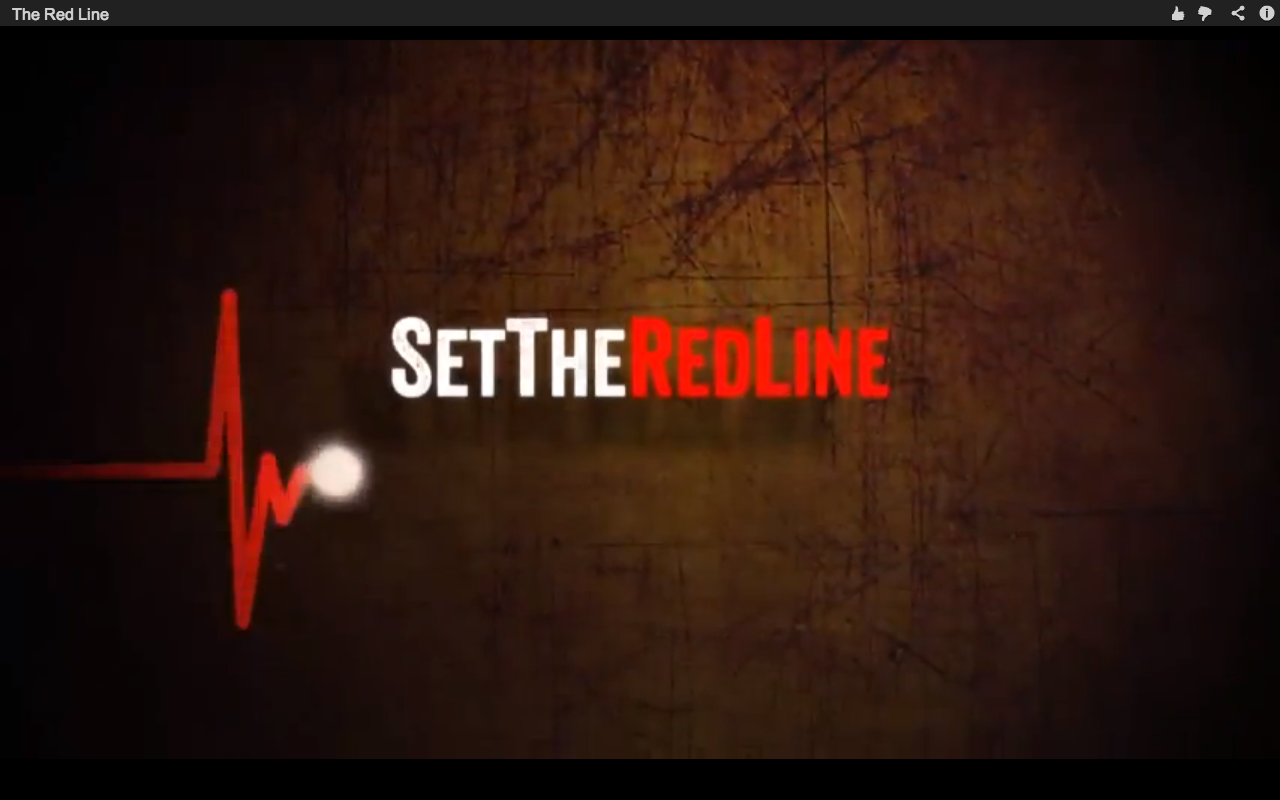A viral video calling on world leaders to a “set the red line” to prevent Iran from acquiring a nuclear weapon has garnered over 1.3 million YouTube views thanks to a savvy social media campaign on Facebook and Twitter.
It’s been promoted by conservative bloggers and Washington-based organizations like the Republican Jewish Coalition and The Israel Project. But the 15-minute-long film is leading some experts to question the filmmaker’s message.
The video is part of an “independent, not-for-profit project designed to harness the global voice of humanity for the purpose of a peaceful solution to prevent a nuclear Iran,” say the film’s two principals, Banafsheh Zand and Shraga Simmons, on their website, settheredline.com.
Zand, who narrates the film, was born in Iran and fled the country during the Iranian revolution in 1979.
Her father, Iranian journalist Siamak Pourzand, committed suicide in 2011 after having been imprisoned since 2001 for writing articles critical of Iran’s political leaders.
Set The Red Line’s narration offers a list of reasons why Iran’s alleged nuclear weapons program must be stopped, including that “Iranian leaders are on a messianic warpath with the ultimate goal of hastening the Mahdi, the messianic Twelfth Imam, to usher in an era of global Islamic domination.”
“Iran has a plan to take over the world, and they view the United States as the ‘Great Satan,’ which must be destroyed,” Zand warns in the film.
“The Iranian regime will push war because that is [their] mandate and they’ve said it everyday and if westerners think that that regime can be deterred … then they will be in for a surprise because that regime has no intention of giving up its nukes,” Zand told The American Independent in an email.
The film endorses ongoing diplomatic efforts to find a peaceful solution to tensions over Iran’s nuclear program but urges viewers to support a “backup solution” should diplomacy fail.
“We must continue and even intensify the various diplomatic methods that world leaders have worked so hard to implement. But the reality is that Iran’s nuclear clock is ticking faster than the diplomatic clock,” says Zand in the film. “So we need an effective and reliable backup solution. It’s called the Red Line.”
Viewers are urged to participate in a social media campaign to push world leaders to lay down the “red line,” defined in the film as “world leaders make a pronouncement outlining a clear and unambiguous set of criteria that will serve as fair warning to Iran that crossing this line will trigger a devastating military response.”
“Pragmatically, the red line puts us in a much better position of going up against a non-nuclear Iran than having to face the certainty of war against a genocidal and nuclear Iran,” says Zand later in the film.
“The red line is specifically and only for the purpose of getting world leaders to pressure the Iranian regime to give up their nuclear weapons. I do not support any external military action on Iran,” Zand told TAI.
“Why would anyone attack a country whose people loath it?” Zand asked TAI. “Why would anyone attack a country with suicide bombers deployed around the world?”
“The Khomeinist regime totally intends to kill Westerners, Israelis, Palestinians and Arabs because they believe that they (the Shia Twelvers) are the ‘anointed’ ones and … they believe that it is the duty of all Muslims to die in the name of the Islamic pole that the Khomeinists have decided to head,” said Zand to TAI. “[T]hat regime openly says that it is Muslim duty to die, as collateral damage and that Sunnis have no say in the matter.”
Simmons told TAI that “military action should only be a last resort, when sanctions, diplomatic isolation and negotiations have failed to stop the regime.”
In interviews with TAI, experts questioned the approach outlined in the film.
“The video is conveniently vague so we never know to whom we’ll leave it to draw this red line. The US? Israel? The United Nations Security Council?” said Iran expert and author Barbara Slavin. “All we’re told is that it has to happen before Iran develops nuclear weapons. If Iran crosses this line it triggers a devastating response, say the filmmakers. This sounds more like an argument for war than an effort to prevent it.”
Matt Duss, a policy analyst at the liberal Center for American Progress, also criticized the film.
“Like most of the most hawkish arguments about Iran it’s plagued by a fundamental contradiction,” said Duss. “One is this claim, which is highly arguable, that Iran’s leaders are determined to destroy the west and this is a non-negotiable element of their extremist Muslim beliefs; and we must set a red line. These two things are contradictory. If Iran’s threat to destroy the west is nonnegotiable then why would they take a red line seriously?”
He added, “There’s this idea that Iran’s leaders are all apocalyptic crazies looking to trigger the return of the Shiite messiah, but there’s little evidence to suggest these beliefs drive Iranian policy.”
Zand, speaking in the film, says that Saudi Arabia, Kuwait, Qatar, Bahrain, Jordan, the UAE, and Iraq “would all fall like dominoes” if faced with an aggressive, nuclear-armed Iran.
But, according to Slavin, “there is absolutely no indication that there would be regime change in any of these places.”
“If Iran got a nuclear weapon the Saudis and all the countries across the Persian Gulf would probably shore up their alliances with the US even more and there would be a vigilant effort to contain Iran,” Slavin went on to add.
Set The Red Line garnered over one million YouTube views thanks to an effective social media campaign, said the film’s director.
“It was very grassroots, which to me is a huge success,” said Simmons. “Thousands of individuals sent the film out to their private email lists and posted on Facebook. We also contacted approximately 1,000 ‘Facebook administrators’ whose groups deal with issues of foreign affairs. I know for certain that a number of very large Facebook groups (with a million followers) promoted it to their lists.”
The Israel Project, “a one-stop source for detailed and accurate information about Israel and the Middle East,” according to its website, promoted the film both on its website andon Twitter.
Twitter accounts belonging to the Republican Jewish Coalition and a Fox News Produceralso promoted the film.
Neither Simmons nor Zand is new to political activism.
Simmons is senior editor of Aish.com, the online outreach arm of the Orthodox Jewish organization Aish HaTorah. His blog posts frequently criticize what he sees as biased reporting by journalists covering Israel.
Simmons accused CBS’s 60 Minutes of “further demonizing Israel and eroding its support in the West” after the show aired a segment examining the treatment of Palestinian Christians in the Israeli-occupied West Bank.
In a November 18, 2012, post — written during the Israel Defense Forces’ “Operation Pillar of Defense” in the Gaza Strip — Simmons criticized CNN’s Zain Verjee’s “horribly biased” interview of Israeli government spokesperson Mark Regev. Verjee asked about reports of children wounded by Israeli airstrikes and questioned how the IDF’s actions help bring peace to the region.
Verjee “sounds like she’d be more comfortable on Hamas TV,” wrote Simmons.
Simmons emphasized that his work on Set The Red Line was conducted independently from his job at Aish HaTorah.
“It happens that I am employed as an editor at the Aish.com website,” said Simmons. “I knew that the credibility of the message required full independence, so I took a full leave of absence from that position to enable me to make the film independently, without any organizational involvements whatsoever.”
Zand explained to TAI that she and Simmons spoke on Skype about making the film and shortly thereafter she was flown to Israel to narrate the film.
“I don’t even know what Aish HaTorah is,” said Zand. “We both agree Iran is out of order and intends to kills westerners and Israelis. Neither one of us want war.”
Tax disclosures show that from 2005 to 2010, Simmons served as secretary of Honest Reporting, a group that characterizes itself as “monitor[ing] the news for bias, inaccuracy, or other breach of journalistic standards in coverage of the Arab-Israeli conflict.”
Honest Reporting apparently participated in the release of Obsession: Radical Islam’s War Against The West, a 2005 film that compared the rise of radical Islam to the rise of Nazism in the 1930s.
The film’s website warns, “As we sleep in the comfort of our homes, a new evil rises against us. A new menace is threatening, with all the means at its disposal, to bow Western Civilization under the yoke of its values. That enemy is Radical Islam.”
“[Honest Reporting] now denies any involvement in the production of ‘Obsession.’ But its website promoted it as an Honest Reporting project in 2005, the year it was first released,” reported Sara Posner in a 2008 Jewish Week article.
As Posner reported, an archived version of the Honest Reporting website from June 14, 2006, shows Obsession listed as an “affiliate” project. The site also declared at the time: “HonestReporting’s ‘Obsession’ Wins Award at WorldFest Independent Film Festival.”
The film gained mainstream attention after 28 million DVDs were distributed to swing-state voters via newspaper inserts and bulk mailings before the 2008 U.S. presidential election.
Set The Red Line was Zand’s first collaboration with Simmons but not her first foray into political advocacy.
Her LinkedIn profile states that from February 2010 to October 2012, the month Set The Red Line was released, she worked as a consultant at Iran180, a group that “demand[s] a 180 by the Iranian government on their pursuit of nuclear weapons and the treatment of their citizens,” according to its website. Iran180’s outreach director, Chris DeVito, told TAI that Zand no longer works with the organization.
DeVito declined to offer a detailed opinion on the film but stated, “There are elements of the narrative that are extremely important and entirely valid.”






My wish list
– a video showing 200 missiles with nuclear and hydrogen bomb warheads with an Israeli flag on the missiles and explaining how many countries these can wipe off the map
– a video showing map of Palestine in 1947 with all the Palestinian town and villages on the one hand and a map showing destoryed vilalges and settlements in 2012 on he other hand
– a video contrasting ruins of Gaza with posh seaside high rises of Tel Aviv.
– a documentary that exposes how much money is given to Israel through private donations and governments and how this aid is what fuels expansionism, whence making any criticism of settlements a sheer hypocrisy